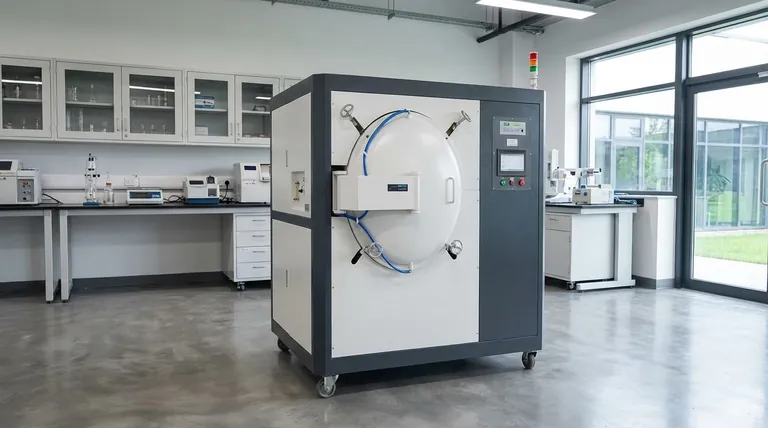At its core, a vacuum furnace provides unparalleled control over the heat treatment environment. It achieves this by removing the atmosphere—and its reactive gases like oxygen—from a sealed chamber. This fundamental difference enables superior material purity, precise temperature uniformity over a wide range, and highly repeatable, computer-controlled process cycles.
The primary benefit of a vacuum furnace is not a single feature, but its ability to create an ultra-clean, stable, and precisely controlled environment. This allows for metallurgical results and component quality that are often unattainable with conventional atmosphere-based furnaces.

The Core Advantage: Absolute Environmental Control
The defining feature of a vacuum furnace is the removal of air. This seemingly simple step has profound implications for the material being processed.
Eliminating Contamination and Oxidation
By evacuating the chamber, the process eliminates the primary sources of contamination: oxygen, nitrogen, and water vapor. This prevents unwanted surface reactions like oxidation (rusting) and decarburization (the loss of carbon from the surface of steel).
Parts processed in a vacuum emerge from the furnace clean and "bright," often without the need for subsequent chemical cleaning or mechanical finishing.
Achieving Unmatched Purity
A vacuum environment doesn't just prevent new contaminants from being introduced; it actively removes existing ones from the material itself.
This process, known as outgassing, uses the low-pressure environment to pull trapped gases and other volatile elements from deep within the workpiece. The result is a finished component with higher purity and improved structural integrity.
Precision and Consistency in Every Cycle
Beyond cleanliness, a vacuum furnace offers a level of process control that ensures every part meets exacting specifications, cycle after cycle.
Uniform Temperature Distribution
In a vacuum, heat is transferred primarily through radiation, not convection. This allows for exceptionally uniform heating, minimizing hot spots and cold spots across the entire workload.
The result is consistent metallurgical properties throughout the component, which is critical for high-performance and stress-bearing applications.
Rapid and Controlled Cooling (Quenching)
Once the heating cycle is complete, vacuum furnaces can rapidly cool parts by backfilling the chamber with a high-pressure, inert gas like nitrogen or argon.
This quenching process is precisely controlled, allowing metallurgists to achieve specific hardness levels and microstructures. It also significantly shortens the overall process cycle time.
Guaranteed Metallurgical Repeatability
Modern vacuum furnaces are fully automated. Every parameter—from the vacuum level to the heating ramp rates, soak times, and cooling profiles—is managed by a computer.
This automation removes operator variability and guarantees that the process is identical every time, ensuring consistent, repeatable results that are essential for quality standards in industries like aerospace and medical devices.
Understanding the Trade-offs
While powerful, vacuum furnaces are not the universal solution for all heat treatment needs. Objectivity requires acknowledging their limitations.
Higher Initial Investment
Vacuum furnaces represent a significantly higher capital investment compared to traditional atmosphere furnaces. The cost of the chamber, pumping systems, and advanced controls is substantial.
Cycle Time Considerations
Although quenching is very fast, the time required to pump the chamber down to the target vacuum level can extend the overall cycle time. For some high-volume, non-critical parts, a continuous atmosphere furnace may be faster.
Maintenance Complexity
The high-performance vacuum systems, including pumps, seals, and instrumentation, require specialized maintenance and expertise to keep them operating at peak efficiency.
Is a Vacuum Furnace Right for Your Application?
The decision to use a vacuum furnace should be driven by the specific requirements of your component and material.
- If your primary focus is maximum material purity and surface integrity: A vacuum furnace is the definitive choice, especially for reactive metals (like titanium), medical implants, or components where a pristine surface is non-negotiable.
- If your primary focus is process repeatability for high-value components: The precise computer control of a vacuum furnace eliminates variables, making it ideal for aerospace, defense, and critical tooling applications where failure is not an option.
- If your primary focus is high-volume, low-cost heat treatment of simple steels: A conventional atmosphere furnace is often a more cost-effective solution, provided minor surface oxidation and slight process variations are acceptable.
Ultimately, choosing a vacuum furnace is an investment in quality, precision, and repeatability.
Summary Table:
| Benefit | Key Advantage | Ideal For |
|---|---|---|
| Purity & Surface Integrity | Eliminates oxidation and contamination | Reactive metals, medical implants |
| Precision & Uniformity | Uniform heating via radiation, no hot spots | Aerospace, tooling, high-performance parts |
| Repeatability & Automation | Computer-controlled cycles for consistent results | Critical applications where failure is not an option |
Ready to elevate your heat treatment process with the precision of a vacuum furnace? KINTEK specializes in providing advanced lab equipment and consumables, including vacuum furnaces tailored for laboratories that demand the highest standards of material purity and process repeatability. Whether you're working with reactive metals, medical implants, or critical aerospace components, our expertise ensures you get the right solution for your specific needs. Contact us today to discuss how a KINTEK vacuum furnace can bring unparalleled quality and control to your lab!
Visual Guide

Related Products
- Vacuum Heat Treat Furnace with Ceramic Fiber Liner
- Molybdenum Vacuum Heat Treat Furnace
- 2200 ℃ Graphite Vacuum Heat Treat Furnace
- Vacuum Hot Press Furnace Heated Vacuum Press Machine Tube Furnace
- 2200 ℃ Tungsten Vacuum Heat Treat and Sintering Furnace
People Also Ask
- What is the standard thickness of plating? Optimize Durability, Corrosion & Cost
- How to vacuum out a furnace? A Step-by-Step Guide to Safe DIY Maintenance
- Can I vacuum the inside of my furnace? A Guide to Safe DIY Cleaning vs. Professional Service
- What materials are used in a vacuum furnace? Selecting the Right Hot Zone for Your Process
- Why do you vacuum for heat treatment? Achieve Flawless, High-Performance Metal Components



















